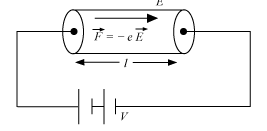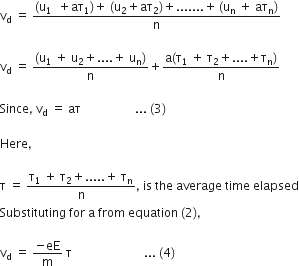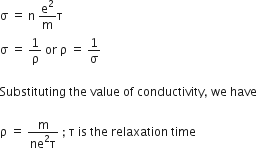(i) Define the term drift velocity.
(ii) On the basis of electron drift, derive an expression for resistivity of a conductor in terms of number density of free electrons and relaxation time. On what factors does resistivity of a conductor depend?
(iii) Why alloys like constantan and manganin are used for making standard resistors?
i)
Drift velocity is the average velocity of the free electrons in the conductor with which they get drifted towards the positive end of the conductor under the influence of an external electric field.
ii)
Free electrons are in continuous random motion. They undergo change in direction at each collision and the thermal velocities are randomly distributed in all directions. ![]()

Electric field, E = -eE
Acceleration of each electron, ![]() ... (2)
... (2)
Here,
m = mass of an electron
e = charge on an electron
Drift velocity is given by, ![]()

Electrons are accelerated because of the external electric field.
They move from one place to another and current is produced.
For small interval dt, we have
I dt = -q ; where q is the total charge flowing
Let, n be the free electrons per unit area. Then, total charge crossing area A in time dt is given by,
Idt = neAvd dt
Substituting the value of vd, we get
I.dt = neA ![]()
Current density, J = ![]()
From ohm's law, we have
J = ![]()
Here, ![]() is the conductivity of the material through which the current is flowing,
is the conductivity of the material through which the current is flowing,
Thus, 
iii)
Alloys like constantan and manganin are used for making standard resistors because:
a) they have high value of resistivity
b) temperature coefficient of resistance is less.
